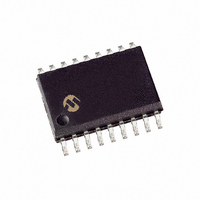MCP2510-I/SO Microchip Technology, MCP2510-I/SO Datasheet - Page 49

MCP2510-I/SO
Manufacturer Part Number
MCP2510-I/SO
Description
IC CAN CONTRLER IND TEMP 18SOIC
Manufacturer
Microchip Technology
Specifications of MCP2510-I/SO
Package / Case
18-SOIC (7.5mm Width)
Controller Type
CAN Interface
Interface
SPI
Voltage - Supply
3 V ~ 5.5 V
Current - Supply
10mA
Operating Temperature
-40°C ~ 85°C
Mounting Type
Surface Mount
Product
Controller Area Network (CAN)
Number Of Transceivers
1
Data Rate
5 Mbps
Supply Voltage (max)
5.5 V
Supply Voltage (min)
3 V
Supply Current (max)
10 mA
Maximum Operating Temperature
+ 85 C
Minimum Operating Temperature
- 40 C
Mounting Style
SMD/SMT
Lead Free Status / RoHS Status
Lead free / RoHS Compliant
For Use With
DV251001 - KIT DEVELOPMENT CAN MCP2510
Lead Free Status / Rohs Status
Lead free / RoHS Compliant
Available stocks
Company
Part Number
Manufacturer
Quantity
Price
Part Number:
MCP2510-I/SO
Manufacturer:
MICROCHIP/微芯
Quantity:
20 000
8.0
The MCP2510 is designed to be operated with a crystal
or ceramic resonator connected to the OSC1 and
OSC2 pins. The MCP2510 oscillator design requires
the use of a parallel cut crystal. Use of a series cut crys-
tal may give a frequency out of the crystal manufactur-
ers specifications. A typical oscillator circuit is shown in
Figure 8-1. The MCP2510 may also be driven by an
external clock source connected to the OSC1 pin as
shown in Figure 8-2 and Figure 8-3.
8.1
The MCP2510 utilizes an oscillator startup timer (OST),
which holds the MCP2510 in reset, to insure that the
oscillator has stabilized before the internal state
machine begins to operate. The OST maintains reset
for the first 128 OSC1 clock cycles after power up,
RESET, or wake up from sleep mode occurs. It should
be noted that no SPI operations should be attempted
until after the OST has expired.
FIGURE 8-1:
FIGURE 8-2:
© 2007 Microchip Technology Inc.
Note 1: A resistor to ground may be used to reduce system noise. This may increase system current.
Note 2: Duty cycle restrictions must be observed (see Table 12-2).
OSCILLATOR
Oscillator Startup Timer
Note 1: A series resistor, R
Note 2: The feedback resistor, R
CRYSTAL/CERAMIC RESONATOR OPERATION
EXTERNAL CLOCK SOURCE
external system
Clock from
C
C
1
2
R
XTAL
S
OSC1
(1)
OSC2
Open
(1)
S
, may be required for AT strip cut crystals.
R
F
F
, is typically in the range of 2 to 10 MΩ.
(2)
8.2
The clock out pin is provided to the system designer for
use as the main system clock or as a clock input for
other devices in the system. The CLKOUT has an inter-
nal prescaler which can divide F
The CLKOUT function is enabled and the prescaler is
selected via the CANCNTRL register (see Register 9-
1). The CLKOUT pin will be active upon system reset
and default to the slowest speed (divide by 8) so that it
can be used as the MCU clock. When sleep mode is
requested, the MCP2510 will drive sixteen additional
clock cycles on the CLKOUT pin before entering sleep
mode. The idle state of the CLKOUT pin in sleep mode
is low. When the CLKOUT function is disabled (CAN-
CNTRL.CLKEN = ‘0’) the CLKOUT pin is in a high
impedance state.
The CLKOUT function is designed to guarantee that
t
CLKOUT pin function is enabled, disabled, or the pres-
caler value is changed.
h CLKOUT
SLEEP
To internal logic
OSC1
OSC2
CLKOUT Pin
and t
l CLKOUT
timings are preserved when the
MCP2510
OSC
DS21291F-page 49
by 1, 2, 4 and 8.

















